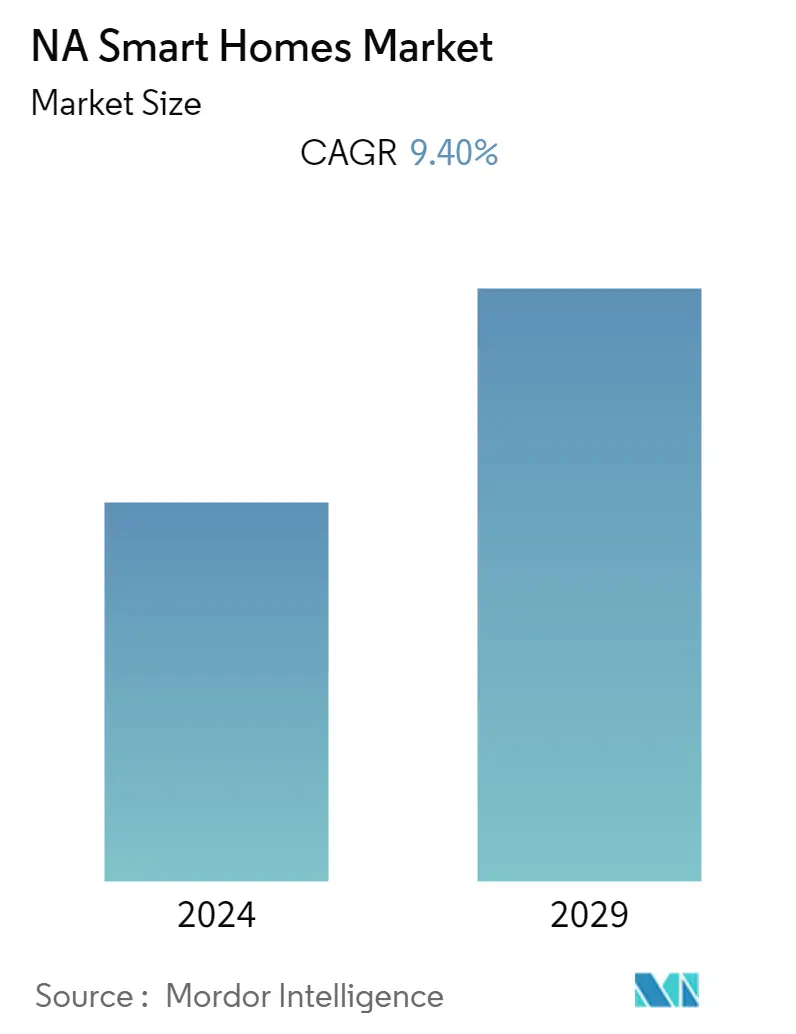Market Size of NA Smart Homes Industry

| Study Period | 2019 - 2029 |
| Base Year For Estimation | 2023 |
| Forecast Data Period | 2024 - 2029 |
| Historical Data Period | 2019 - 2022 |
| CAGR | 9.40 % |
| Market Concentration | High |
Major Players
*Disclaimer: Major Players sorted in no particular order |
Need a report that reflects how COVID-19 has impacted this market and its growth?
North America Smart Homes Market Analysis
The North America Smart Homes Market is expected to grow at a CAGR of 9.4% over the forecast period 2021-2026.
- With the significant rollout of 5G in the United States and improved Wi-Fi technology, such as Wi-Fi 6, smart home devices may be linked by faster, more powerful networks, meaning better access to processing and data resources in the cloud. 5G technology is also revolutionizing IoT services' delivery, including smart home technology, as it allows devices to work free of wires and cables while consuming a minimal amount of power.
- AT&T, Verizon, T-Mobile, and Sprint launched their 5G wireless networks toward the end of 2020. Hence, 5G is currently available to customers in select cities across the United States. However, it is expected to take a few years before full-fledged, top-speed 5G coverage is available across the country, like 4G LTE. T-Mobile also announced that it would be launching a 5G - based home network by 2024. The aim is to extend coverage to previously underserved rural areas across the United States. It is currently offering a trial version of the service on its 4G LTE network to a select number of T-Mobile customers.
- In the region, the increasing demand for energy-efficient solutions is a major trend that is leading towards the adoption of the smart home solution. According to the US Energy Information Administration, the average household in the United States consumed 20.75 quadrillion BTUs of energy in 2020, where a sign of that energy is being wasted. According to US DoE, the average household used energy that released an estimated 17,320 lbs. of CO2. To put this number in another perspective, on an annual basis, the average household is responsible for releasing 70% more CO2 emissions in comparison to the average passenger vehicle. Such instances are addressing the demand for smart home solutions.
- ValuePenguin surveyed more than 1,000 individuals and found that those concerned with the environment are purchasing smart home devices at a faster rate. 65%% of Americans have at least one smart home device, and many purchased the smart technology because it's better for the environment. The most popular smart home devices among the respondents included speakers (31%), thermostats (24%), and lighting (20%).
- Further, smart speakers are essential because they represent a new interactive digital endpoint in the home that now provides access to over one-third of US adults. This digital endpoint is available to market pioneers such as Amazon and Google to third-party voice app developers. The rise in video chatting has spurred growth in smart speakers with a display.
- The consumer's propensity to adopt security solutions is on the rise due to the pandemic and the uncertainty of returning to normal life. The aspect of a 'smart home' is looking more practical in the 'new normal,' post-COVID-19. Currently, it is not about efficiencies or smart usages, like smart options of switching on of a luminaire or an HVAC, but the practical reality of ensuring fewer instances of touching, if not doing away altogether, off switches to switch on any appliance.
